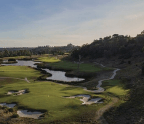25+ YEARS OF TIGER WOODS

“WHAT GOLF NEEDED AS 1996 CAME TO A CLOSE WAS A RIVALRY. IT TURNED OUT TIGER DIDN’T “DO” RIVALRY”
1 HELLO WORLD
How a new superstar was born, and the game changed forever
With the exception of Nick Faldo’s dismantling of Greg Norman at the Masters, 1996 will not be remembered as a vintage year for the Major championships. If ever a sport could be accused of living up to its staid image of a game for middle-aged white men, this was it. Golf was crying out for something or, more pertinently, someone new.
Faldo’s crushing of Norman is the stuff of legend. In almost every sense, it was glory’s last shot. Faldo grabbed his chance, landing his sixth and final Major. Norman, with two Opens to his name and more than five years in total at the top of the world rankings, crumbled. Neither player reached such heights again. It was a watershed moment.
But what of the other Majors that year? Were the golfing gods so preoccupied with the project that was Tiger Woods that they handed them out almost at random? The U.S. Open went to Steve Jones, 38; The Open to Tom Lehman, 37; the PGA Championship to Mark Brooks, 35. The Great Triumvirate? No.
It had been a full decade since Jack Nicklaus landed the last of his 18 Majors, the 1986 Masters. He was 46 at the time and had not been a serious contender for a number of years. What the Golden Bear had, though, was star quality. As had Arnold Palmer before him, all film star looks and John Wayne swagger.
Into the void left by Nicklaus came a sparkling European contingent, led by Severiano Ballesteros. Cavalier and charismatic, Seve single-handedly revived the fortunes of golf in Europe. Where the Spaniard led, Sandy Lyle, Woosie, Langer and Faldo followed. All five invaded the citadel that is Augusta National and all five came away as Masters champions.

There was no welcome with open arms for the Europeans in the United States, however. Ken Schofield, the former chief executive of the European Tour, had to fight long and hard just to get Europe’s finest players into the three Majors played on that side of the Pond. There were to be no mega TV deals signed on the back of a European invasion. Or for that matter, no multi-million dollar endorsements either.
So while the decade of Norman and Europe’s Big Five was drawing to a close, professional golf, in terms of its worldwide appeal and prize funds, was treading water. The PGA Tour was made up of identikit players, many of them well into their 30s. Ernie Els, José Maria Olazabal and Phil Mickelson bucked the trend, but if ever a player illustrated the public’s hunger for something out of the ordinary, it was John Daly, shock winner of the PGA Championship in 1991 and The Open four years later. Golf’s anti-hero, Daly was anything but American country club material. He smoked and drank to excess, looked like he had never set foot inside a gym and yet, with his unique overswing, drove the ball colossal distances. His own brand of car-crash golf – sublime one minute, calamitous the next – drew the TV cameras and the galleries in their thousands.
What Daly was not, however, was the perfect vehicle for Corporate America. What golf needed most as the curtains came down on another season of Majors in 1996 was one of two things: an intense rivalry (think Palmer versus Nicklaus; Norman versus Faldo) or a superstar. It was about to get the latter. Tiger Woods, as we were about to find out, did not ‘do’ rivalry. Domination was the name of his game.
2 THE ONE-MAN BRAND
The Tiger Woods we witnessed dominating golf was not the real Tiger Woods, but a Nike construct built to transcend the game
I hope we sign him,” said Phil Knight, Nike’s co-founder, as he walked the fairway following 19-year-old Stanford University student Tiger Woods. “If not, I hope he goes to medical school.” Of course Knight did sign him, in an unprecedented deal worth $40m over five years in 1996. Three days later, a news conference was called to announce that Woods was giving up his studies and taking to the PGA Tour as a pro. “Hello world,” said Woods as he made his introduction. “I’ve heard I’m not ready for you. Are you ready for me?”
From that day forward, the story of Tiger Woods has been written as much by Nike’s marketing department as by the man himself. The size of that initial cheque has always played a central role
You’re reading a preview, subscribe to read more.
Start your free 30 days





